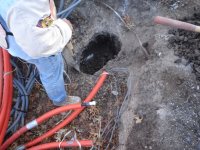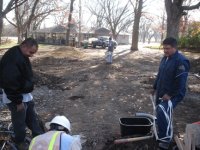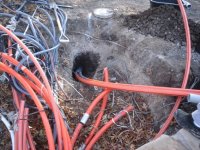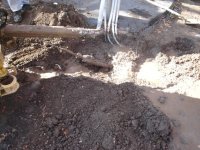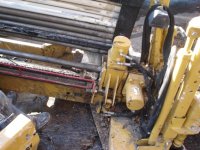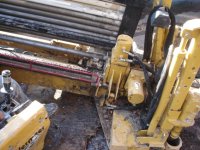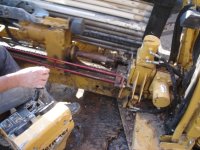OP
You are using an out of date browser. It may not display this or other websites correctly.
You should upgrade or use an alternative browser.
You should upgrade or use an alternative browser.
Keeping character, or restoring a pond
- Thread starter wroughtn_harv
- Start date
- Views: 74763
More options
Who Replied?
/ Keeping character, or restoring a pond
#551
OP
wroughtn_harv
Super Member
OP
wroughtn_harv
Super Member
OP
wroughtn_harv
Super Member
OP
wroughtn_harv
Super Member
The way a directional rig works is the flat side of the "foot" or bit acts like a rudder.
Normally the foot or bit is turning. But when they want to go deeper they put the flat side up and push. This machine was a sixteen-twenty. That means it has sixteen thousand pounds of push and twenty thousand pounds of pull.
They push, spin, push, spin and push until they get reach the desired depth or angle of bore. Then it's back to spinning again.
The receiver tells them exactly where it is for depth and location. A gauge on the boring unit tells the operator the orientation of the foot or bit.
This bore cost about seven fifty a foot plus the cost of pipe.
The advantages of the bore is there's no trench with it's destruction of the surface and tree roots etc. There will be no settling to worry about that you have over a trench line.
The boring unit is a hydraulic marvel.
The operator sits there and flips switches and operates levers while watching gauges.
While boring the machine hydraulically ads lengths of drill stem as required. When pulling it puts the stem back into the carriage.
Normally the foot or bit is turning. But when they want to go deeper they put the flat side up and push. This machine was a sixteen-twenty. That means it has sixteen thousand pounds of push and twenty thousand pounds of pull.
They push, spin, push, spin and push until they get reach the desired depth or angle of bore. Then it's back to spinning again.
The receiver tells them exactly where it is for depth and location. A gauge on the boring unit tells the operator the orientation of the foot or bit.
This bore cost about seven fifty a foot plus the cost of pipe.
The advantages of the bore is there's no trench with it's destruction of the surface and tree roots etc. There will be no settling to worry about that you have over a trench line.
The boring unit is a hydraulic marvel.
The operator sits there and flips switches and operates levers while watching gauges.
While boring the machine hydraulically ads lengths of drill stem as required. When pulling it puts the stem back into the carriage.
Attachments
OP
wroughtn_harv
Super Member
OP
wroughtn_harv
Super Member
tlbuser
Veteran Member
<font color="blue"> The advantages of the bore is there's no trench with it's destruction of the surface and tree roots etc. There will be no settling to worry about that you have over a trench line.
The boring unit is a hydraulic marvel.
</font>
The downside can be that anything in it's path gets bored. Like septic lines /forums/images/graemlins/shocked.gif We just finished a job repairing six lines (different lots) that the new power distribution lines were strung through. Good news for me, not so good for the others.
The boring unit is a hydraulic marvel.
</font>
The downside can be that anything in it's path gets bored. Like septic lines /forums/images/graemlins/shocked.gif We just finished a job repairing six lines (different lots) that the new power distribution lines were strung through. Good news for me, not so good for the others.
Cliff_Johns
Elite Member
This thread is a real education. I've said it before and I'll say it again -- thank you for taking the time to post not only the photos, but the play-by-play.
Cliff
Cliff
rox
Veteran Member
Harv,
Wanting to know if you have gotten sufficient rains so that the pond actually has water in it? Been waiting to see the finish photographs of the pond with water. How has the weather been?
Wanting to know if you have gotten sufficient rains so that the pond actually has water in it? Been waiting to see the finish photographs of the pond with water. How has the weather been?
